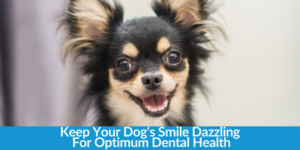Keep Your Dog’s Smile Dazzling For Optimum Dental Health
Dogs, just like people, need their teeth for more than just chewing. Maintaining regular dental health at home for your dog takes just a few minutes a day. Still, it will help dogs smile and prevent tooth loss, periodontal disease, and other health concerns.
Early Signs of Dental Problems
Tooth loss in dogs, as well as issues such as gingivitis and periodontal disease, becomes more problematic as dog’s age. However, even puppies can have genetic, disease, or dietary factors that contribute to poor oral health.

The most common signs of problems in your dog’s mouth include:
- Bad breath – this is beyond doggy breath and is not related to specific foods
- Bleeding of the gums
- Food falling out of the mouth when chewing
- Swelling of the jaw and nose or across the face
- Mucous discharge from the nose
- Pawing at the mouth
- Weight loss
- Lack of appetite or food refusal
- Teeth are missing
- Yellow, brown, or even dark brown or black deposits start at the base of the teeth
A noticeable discoloration or coating of the teeth starting at the gum line is actually bacteria and minerals in the saliva that have formed plaque and tartar. If this is not corrected, it will advance down the root of the tooth, leading to infections in the gums and periodontal disease. In addition to tooth loss, the bacteria can also migrate through the dog’s body, resulting in damage to the kidneys, liver, and heart. Canine periodontal disease is considered a cause of death in older dogs.
Home Routines
Dog owners can help their pet maintain their teeth and gums with just a few simple steps. Ideally, brushing your dog’s teeth with specially formulated peanut butter or chicken flavored toothpaste becomes a pleasant part of the grooming routine for the dog. Special smaller and soft dog toothbrushes or finger sleeves can be used to gently stimulate the gum line and brush the surface of the teeth. Do not use human toothpaste for a dog as it can contain potentially dangerous and toxic ingredients to pets.
The toothbrushing routine does not need to happen every day, with most vets recommending two to three times a week. You can also choose disposable tooth wipes for the dog, but they do not get into the spaces between teeth like the bristles on the finger sleeves and the toothbrushes.
In addition to brushing, consider the following dog dental health routines:
- Dog dental treats – check with your vet for recommendations for the size and brand of dog dental treats. These are not used as rewards for training and should only be provided to the dog once or twice a week.
- Quality dog chews and toys– dog chews or toys with texturized surfaces help to remove plaque and stimulate the gums. They also stimulate the production of saliva, which is also good for dental health. Raw bones (of the correct size and type) and other pre-made dog chews are good options.
Also, talk to your vet about routine dental cleaning for your dog. Every dog has different dental needs. Based on this information, there are a variety of procedures your vet may recommend to keep your dog’s teeth clean and healthy.

